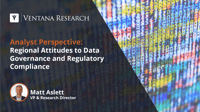I first wrote about a new era of trade a few years ago to make the point that the period of optimizing supply chains for the lowest cost was over, and that companies needed to redesign them to achieve greater resiliency. That observation proved correct. Now we are hearing about “the end of globalization,” a hyperbolic phrase describing the effects of ongoing changes to the international political order that have been underway for more than a decade. These changes are forcing companies to make...
Read More
Topics:
Continuous Planning,
Business Planning,
Financial Performance Management,
Enterprise Resource Planning,
ERP and Continuous Accounting,
continuous supply chain
Organizations have been using data virtualization to collect and integrate data from various sources, and in different formats, to create a single source of truth without redundancy or overlap, thus improving and accelerating decision-making giving them a competitive advantage in the market. Our research shows that data virtualization is popular in the big data world. One-quarter (27%) of participants in our Data Lake Dynamic Insights Research reported they were currently using data...
Read More
Topics:
embedded analytics,
Analytics,
Business Intelligence,
Streaming Analytics,
AI & Machine Learning
I recently wrote about the importance of data pipelines and the role they play in transporting data between the stages of data processing and analytics. Healthy data pipelines are necessary to ensure data is integrated and processed in the sequence required to generate business intelligence. The concept of the data pipeline is nothing new of course, but it is becoming increasingly important as organizations adapt data management processes to be more data driven.
Read More
Topics:
Analytics,
Business Intelligence,
Data Governance,
Data Integration,
Data,
Digital Technology,
Digital transformation,
data lakes,
data operations,
Digital Business,
AI & Machine Learning,
data platforms,
Analytics & Data,
Streaming Data & Events
Data governance is an issue that impacts all organizations large and small, new and old, in every industry, and every region of the world. Data governance ensures that an organization’s data can be cataloged, trusted and protected, improving business processes to accelerate analytics initiatives and support compliance with regulatory requirements. Not all data governance initiatives will be driven by regulatory compliance; however, the risk of falling foul of privacy (and human rights) laws...
Read More
Topics:
Analytics,
Data Governance,
Data
Although the bulk of contact center seats are still served by on-premises equipment, there appears to be a consensus that the cloud is better suited to delivering a successful, omnichannel customer experience, and that most new contact center deployments will be run on cloud-computing platforms.
Read More
Topics:
Contact Center,
CCaaS
I recently described the growing level of interest in data mesh which provides an organizational and cultural approach to data ownership, access and governance that facilitates distributed data processing. As I stated in my Analyst Perspective, data mesh is not a product that can be acquired or even a technical architecture that can be built. Adopting the data mesh approach is dependent on people and process change to overcome traditional reliance on centralized ownership of data and...
Read More
Topics:
Business Continuity,
Analytics,
Business Intelligence,
Data Governance,
Data Integration,
Data,
Digital Technology,
data lakes,
Digital Business,
data platforms,
Analytics & Data
How payments are effected is an afterthought to many involved in a transaction, but flaws in this process can be a source of pain and frustration for those in the back office, especially in accounting and treasury. To improve the way payments are handled in business-to-business transactions, the once ubiquitous paper checks are giving way to electronic payments. This category includes credit, debit and virtual cards, wire transfers, as well as ACH (Automated Clearing House) transmissions that...
Read More















